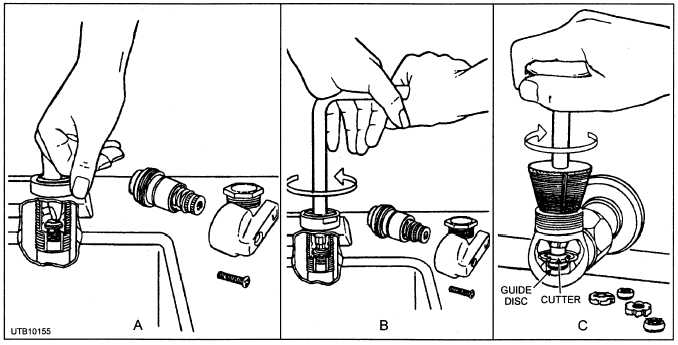washers do not give long service, particularly in hot-water lines.
4. If the brass screw is in poor condition, replace it with a new one (view A, fig. 5-46).
5. Examine the valve seat and repair or replace it with a new one (view B, fig. 5-46), if necessary, before replacing the spindle; otherwise, a new washer provides adequate service for only a short time.
6. Reface or ream solid seats (view C, fig. 5-46) with a standard reseating tool consisting of a cutter, a stem, and a handle. Rotate the tool with the cutter centered and held firmly on the worn or scored seat. Take care to prevent excessive reaming. Remove all grinding residue before reassembly. A solid seat can be replaced with a renewable seat by tapping a standard thread into the old solid seat and inserting a renewable seat.
7. Remove renewable seats with a regular seat- removing tool or Allen wrench. When the seat is frozen to the body, apply penetrating oil to loosen it. Faucet seats can usually be tapped, reseated, or replaced without removing the faucet from its fixture.
8. To stop leakage at the bonnet, replace the stem packing and the bib gasket.
Occasionally, you may find ball-bearing washer holders installed in faucets at some activities. The ball bearings between the stem and washer holder permit movement of the "washer" free of the movement of the stem. This allows the washer to stop its rotation on the slightest contact with the seat, thereby reducing the frictional wear of the washer.
SHOWER HEADS
Shower heads that supply an uneven or distorted stream can usually be repaired by removing the perforated faceplate and cleaning the mineral deposits from the back of the plate with fine sandpaper or steel wool. You can open clogged holes with a coarse needle or compressed air.
Q18. Which part of a faucet requires the most frequent maintenance and repair?
Q19. When a stem washer wears out, you replace it with what type of washer?
SEWER MAINTENANCE AND REPAIR
LEARNING OBJECTIVE: Recognize methods for maintenance and repair of sewer systems.
When you are working with sewers, most of your troubles are with stoppages and breaks. A common cause of a stoppage in a sewer system is tree roots.

Figure 5-46. - Inspecting, removing, and refacing faucet seats.
Continue Reading